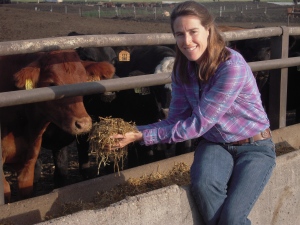When it comes to buying jewelry made of metal, there are lots of options (and terms!) to know. I'm going to break them down for you and what they actually mean:
 Sterling silver:
Sterling silver: Contains 92.5 percent silver and 7.5 percent copper. The copper hardens the overall piece making it 'dent' and mark resistant, but the copper in the metal will react with the oxygen in the air. This results in the dreaded tarnish that eventually forms. (
There are ways to avoid tarnish on silver jewelry.) This jewelry is stamped as 'sterling' or .925
Fine silver: This is 100 percent pure silver. This isn't used much in jewelry that is cast (like the cow jewelry charms), but I have used this when making granulation jewelry. Fine silver is softer than sterling silver. This silver may also be stamped as 'fine silver' or .999
Argentium silver: This contains the 92.5 percent silver, but some of the copper has been replaced with germanium. This silver is more resistant to tarnish than sterling silver, but is also more expensive. Currently,
argentium silver doesn't have its own 'stamp', so pieces made with this type of metal will be called sterling silver.
 24 karat yellow gold
24 karat yellow gold: Pure gold. Very soft and not typically used by itself as jewelry. Also referred to as fine gold. Will be stamped as 'fine gold' or .999
10 karat, 14 karat, 18 karat, and 22 karat gold: Refer to how many parts of the 24 karats that contain gold. The higher the karat number, the more parts of gold in the resulting piece of jewelry. The other metals included in this jewelry are typically silver, copper, nickel and/or palladium. When pricing these items, the price generally fluctuates with the amount of gold in the piece (i.e. 18 karat gold jewelry costs more than 14 karat gold jewelry). The higher amount of gold, the more of a yellow appearance to the piece, but the piece will be softer and less 'dent' resistant. This jewelry is stamped as the appropriate number and K. (e.g. 14K)
White gold: This is yellow gold that is combined with either nickel or
palladium to give it a white appearance.
Rose gold: This is yellow gold that has a higher percentage of copper to give it a 'blush' appearance.
Green gold: Yellow gold that is alloyed with silver only. The final gold has a yellow-green appearance.
Blue/purple gold: Gold that has been alloyed with iron or aluminum. Very difficult to work with after creation and rarely used.
Plated jewelry: This jewelry is made with a more inexpensive metal, usually silver or bronze, then coated with a more expensive metal. The metal is plated by using chemical or electrochemical means.
Gold filled jewelry: This is a process where a solid layer of gold is bonded to a base metal (usually brass) using heat and pressure. The layer of gold is thousands of times thicker than the layer of gold in gold plated jewelry and much more resistant to wear. This process has recently become available for sterling silver as well.
So how do you know what you have?Look for a stamp in the back or inside of the piece.
What if there is no stamp? How do I know?The rules requiring jewelers to place stamps on their products are a bit unclear. We don't have to put on the stamps, especially if we are small production companies (like myself). I choose not to stamp the charms because on many of them, I can't stamp them without detracting from the piece. My advice: if you ever have any questions, ask the person you're buying your jewelry from. If that person isn't available (you're rummaging through an estate sale or got something as a gift) some jewelry repair shops also have commercial kits (using chemicals) that can tell you what your piece of jewelry is made from.
 Today's agriculture website of interest is for the American Sheep Industry Association (ASI). ASI is the national organization representing the interests of more than 82,000 sheep producers located throughout the United States. ASI is a federation of 45 state sheep associations as well as individual members. All ASI officers, board of director members and council and committee members serve as volunteers. The origin of the association dates back to 1865.
Today's agriculture website of interest is for the American Sheep Industry Association (ASI). ASI is the national organization representing the interests of more than 82,000 sheep producers located throughout the United States. ASI is a federation of 45 state sheep associations as well as individual members. All ASI officers, board of director members and council and committee members serve as volunteers. The origin of the association dates back to 1865. 

















